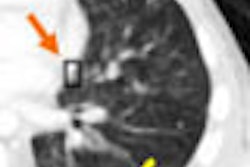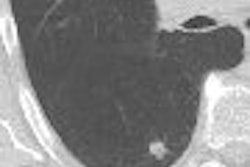Tagging regimens are increasingly popular among virtual colonoscopy providers, who want to optimize lesion conspicuity and thereby avoid undetected lesions. But finding submerged polyps in 2D means paying careful attention to the attenuation of tagged fluid and window settings, according to new research from the U.K.
In a study reported in Radiology, London-based radiologists examined lesion conspicuity of multiple 2D tagging regimens in a porcine model, and found that standard abdominal 2D viewing protocols were likely to result in missed lesions in the presence of higher-attenuation tagging regimens. The attenuation value of tagged fluid was significantly associated with both polyp conspicuity and diameter measurement.
"For relatively dilute suspensions (300 HU or less), conspicuity was significantly improved when abdominal viewing windows were used," wrote Drs. Andrew Slater, Stuart Taylor, David Burling, Louise Gartner, and colleagues from St. Mark's and University College Hospitals in London. "As the attenuation value of tagged fluid increased, however, the performance with both colonic and bone viewing windows became superior" (Radiology, July 2006, Vol. 240:1, pp. 101-109).
The study examined 11 artificial polyps 3-10 mm in diameter that were created in a 25-cm section of porcine colon, trimmed of mesentery and inverted. In this specimen, the polyps were created from real mucosa by puckering the tissue and tying up the base with a purse-string suture. The specimen was submerged in saline.
Four-row MDCT (1.25-mm collimation, pitch 1.5, 120 kVp, 50 mAs) was performed after gas distension, and introduction of six suspensions of diluted barium (Readicat 2%, E-Z-EM, Lake Success, NY; and Baritop, Sanochemia Diagnostics U.K., Bristol, U.K.) in quantities sufficient to submerge the ersatz polyps.
The attenuation values of the barium, tested before imaging each mixture separately, were set to approximate 100, 200, 300, 500, 7000, and 1,000 HU. Attenuation was measured in regions of interest at least 10 cm2 in size, the authors wrote.
Two highly experienced readers independently measured the maximal 2D polyp diameter on each dataset in random order using electronic calipers. Separating each reading by a week, the readers used four viewing windows for each dataset in random order: colon (window level -150 HU, window width 1,500 HU), lung (-500 HU, 1,500 HU), bone (500 HU, 2,500 HU), and abdomen (40 HU, 400 HU), the authors explained.
Polyp conspicuity compared to the air dataset was assigned a grade of 1-4 for each viewing window, with 4 being optimal visualization and 1 being barely or not visible.
The results showed the accuracy of polyp measurement was independent of the viewing window with regard to attenuation of tagged fluid between 100-300 HU, "but differed significantly for 500-1000 HU (p < 0.001)," the team wrote. At the 700-HU attenuation level, however, "there was some evidence that the viewing window used was significantly associated with the accuracy of measurements ... (p = 0.05)." And across all attenuation levels, polyps 5 mm and larger were more conspicuous.
Reader measurement accuracy was good for polyps surrounded by air, and there was no association between the viewing window and diameter measurement. Flat polyps were not addressed in the study.
For submerged polyps, conspicuity differed significantly depending on the viewing window at all attenuation levels (p < 0.001).
"For 100-300 HU with abdominal viewing window, 83% (24 of 29) of observations were assigned grade 3 or 4 (best)," the authors wrote. "For 500-100 HU with bone viewing window, 94% (30 of 32) observations were assigned grade 3 or 4 (superior)."
The best overall conspicuity was achieved using bone viewing windows at 700 HU.
"Polyps were least conspicuous when lung viewing windows were used for all attenuation values," the authors wrote."For each attenuation value from 100 to 300 HU, the abdominal viewing window was superior. Polyps were most conspicuous when bone and colonic viewing windows were used at 500 and 700 HU, whereas polyps were most conspicuous when the bone viewing window alone was used at 1000 HU."
They group concluded that the attenuation value of tagged fluid was significantly associated with both polyp conspicuity and measurement accuracy.
"To put our findings in a clinical context, if standard colonic viewing windows alone were used when we analyzed a tagged dataset, more than half of all submerged polyps would be either invisible or poorly seen if the attenuation value of tagged fluid happened to be either 300 HU or less, or approximately 1,000 HU or more," the team wrote. "It would, therefore, seem advisable to change viewing windows contingent on the attenuation value of tagged fluid when one reviews submerged areas to ensure that no polyp is missed."
The development of robust and accurate subtraction software may ultimately solve many of the difficulties encountered with suboptimal viewing levels, they noted. However, artifacts may limit the effectiveness of such software.
By Eric Barnes
AuntMinnie.com staff writer
July 24, 2006
Related Reading
2D primary reading plus CAD has an edge in VC study, July 11, 2006
Flat polyps foil readers in 16-slice VC study, June 12, 2006
Prepless VC misses some diminutive flat lesions, January 17, 2006
Electronic cleansing improves tolerability of CT colonography, March 29, 2006
Tagged VC succeeds where colonoscopy fails in elderly, March 28, 2006
Copyright © 2006 AuntMinnie.com




















